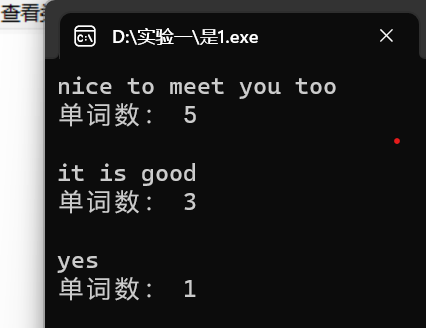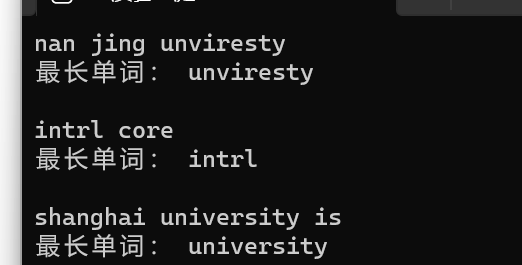实验四
试验任务1
程序源码:
#include <stdio.h> #include<stdlib.h> #define N 4 int main() { int a[N] = {2, 0, 2, 3}; char b[N] = {'2', '0', '2', '3'}; int i; printf("sizeof(int) = %d\n", sizeof(int)); printf("sizeof(char) = %d\n", sizeof(char)); printf("\n"); // 输出int型数组a中每个元素的地址、值 for (i = 0; i < N; ++i) printf("%p: %d\n", &a[i], a[i]); printf("\n"); // 输出char型数组b中每个元素的地址、值 for (i = 0; i < N; ++i) printf("%p: %c\n", &b[i], b[i]); printf("\n"); // 输出数组名a和b对应的值 printf("a = %p\n", a); printf("b = %p\n", b); system("pause"); return 0; }
程序运行截图:
实验结论
int型数组a是连续存放的,每个元素占用4个内存字节单元。char型数组b是连续存放的,每个元素占用1个内存字节单元。
数组名a对应的值,和&a[0]是一样的,数组名b对应的值,和&b[0]是一样的
1.2
程序源码:
#include <stdio.h> #define N 2 #define M 3 int main() { int a[N][M] = {{1, 2, 3}, {4, 5, 6}}; char b[N][M] = {{'1', '2', '3'}, {'4', '5', '6'}}; int i, j; // 输出int型二维数组a中每个元素的地址、值 for (i = 0; i < N; ++i) for (j = 0; j < M; ++j) printf("%p: %d\n", &a[i][j], a[i][j]); printf("\n"); // 输出int型二维数组名a, 以及,a[0], a[1]的值 printf("a = %p\n", a); printf("a[0] = %p\n", a[0]); printf("a[1] = %p\n", a[1]); printf("\n"); // 输出char型二维数组b中每个元素的地址、值 for (i = 0; i < N; ++i) for (j = 0; j < M; ++j) printf("%p: %c\n", &b[i][j], b[i][j]); printf("\n"); // 输出char型二维数组名b, 以及,b[0], b[1]的值 printf("b = %p\n", b); printf("b[0] = %p\n", b[0]); printf("b[1] = %p\n", b[1]); printf("\n"); return 0; }
程序运行截图:

1.int型二维数组是按行连续存放的,每个元素占4个字节。2.在数字面值上是一样的 3.char型数组是按行存放的。4.在数字面值上是一样的 5. 每个元素的字节数等于每行的元素个数。
试验任务2
程序源码:
#include <stdio.h> #include <string.h> #define N 80 void swap_str(char s1[N], char s2[N]); void test1(); void test2(); int main() { printf("测试1: 用两个一维维数组,实现两个字符串交换\n"); test1(); printf("\n测试: 用二维数组,实现两个字符串交换\n"); test2(); return 0; } void test1() { char views1[N] = "hey, C, I hate u."; char views2[N] = "hey, C, I love u."; printf("交换前: \n"); puts(views1); puts(views2); swap_str(views1, views2); printf("交换后: \n"); puts(views1); puts(views2); } void test2() { char views[2][N] = {"hey, C, I hate u.", "hey, C, I love u."}; printf("交换前: \n"); puts(views[0]); puts(views[1]); swap_str(views[0], views[1]); printf("交换后: \n"); puts(views[0]); puts(views[1]); } void swap_str(char s1[N], char s2[N]) { char tmp[N]; strcpy(tmp, s1); strcpy(s1, s2); strcpy(s2, tmp); }
程序运行截图:

实验任务3
3.1程序源码:
#include <stdio.h> #define N 80 int count(char x[]); int main() { char words[N+1]; int n; while(gets(words) != NULL) { n = count(words); printf("单词数: %d\n\n", n); } return 0; } int count(char x[]) { int i; int word_flag = 0; // 用作单词标志,一个新单词开始,值为1;单词结束,值为0 int number = 0; // 统计单词个数 for(i = 0; x[i] != '\0'; i++) { if(x[i] == ' ') word_flag = 0; else if(word_flag == 0) { word_flag = 1; number++; } } return number; }
程序运行截图:

3.2
程序源码:
/*输入一行英文文本,统计最长单词,并打印输出 */ #include <stdio.h> #define N 1000 int main(){ char line[N]; int word_len;//记录当前单词长度 int max_len;//记录最长单词长度 int end;//记录最长单词结束位置 int i; while(gets(line) != NULL) { word_len = 0; max_len = 0; end = 0; i = 0; while(1){ //跳过连续空格 while(line[i] == ' '){ word_len = 0;//单词长度置0,为新单词统计做猪呢比 i++; } //在一个新单词中,统计当前单词长度 while(line[i] != '\0'&&line[i] != ' '){ word_len++; i++; } //更新更长单词长度,并记录最长单纯结束位置 if(max_len < word_len){ max_len = word_len; end = i;//end保存的是单词结束的下一个坐标位置 } //历遍到文本结束时,终止循环 if(line[i] == '\0') break; } //输出最长单词 printf("最长单词: "); for(i = end - max_len;i<end;++i) printf("%c",line[i]); printf("\n\n"); } return 0; }
程序运行截图:

实验任务4
程序源码:
#include <stdio.h> #define N 5 // 函数声明 void input(int x[], int n); void output(int x[], int n); double average(int x[], int n); void bubble_sort(int x[], int n); int main() { int scores[N]; double ave; printf("录入%d个分数:\n", N); input(scores, N); printf("\n输出课程分数: \n"); output(scores, N); printf("\n课程分数处理: 计算均分、排序...\n"); ave = average(scores, N); bubble_sort(scores, N); printf("\n输出课程均分: %.2f\n", ave); printf("\n输出课程分数(高->低):\n"); output(scores, N); return 0; } // 函数定义 // 输入n个整数保存到整型数组x中 void input(int x[], int n) { int i; for(i = 0; i < n; ++i) scanf("%d", &x[i]); } // 输出整型数组x中n个元素 void output(int x[], int n) { int i; for(i = 0; i < n; ++i) printf("%d ", x[i]); printf("\n"); } // 计算整型数组x中n个元素均值,并返回 // 补足函数average()实现 double average(int x[],int n){ double j = 0.0; int i; for(i = 0 ; i < n; ++i){ j = j + x[i]; } return j / n; } // 对整型数组x中的n个元素降序排序 // 补足函数bubble_sort()实现 void bubble_sort(int x[],int n){ int i,j,k,temp; for(i = 0;i<n-1;i++) { k = i; for(j = i+1;j<n;j++) { if(x[j]>x[k]){ k = j;} } if(k != i){ temp = x[i]; x[i] = x[k]; x[k] = temp;} } printf("%d",x[i]); }
程序运行截图:

实验任务5
程序源码:
#include <stdio.h> #include <math.h> #define N 100 void dec2n(int x, int n); // 函数声明 int main() { int x; printf("输入一个十进制整数: "); while(scanf("%d", &x) != EOF) { dec2n(x, 2); // 函数调用: 把x转换成二进制输出 dec2n(x, 8); // 函数调用: 把x转换成八进制输出 dec2n(x, 16); // 函数调用: 把x转换成十六进制输出 printf("\n输入一个十进制整数: "); } return 0; } // 函数定义 // 功能: 把十进制数x转换成n进制,打印输出 // 补足函数实现 // ××× void dec2n(int x,int n){ int s1[100]; int c,i=0; while(1){ c=x%n; x=x/n; s1[i]=c; if(x==0) break; i++; } for (int j=i;j>=0;j--){ if (s1[j]>=10){ switch (s1[j]){ case 10:printf("%c",'A');break; case 11:printf("%c",'B');break; case 12:printf("%c",'C');break; case 13:printf("%c",'D');break; case 14:printf("%c",'E');break; case 15:printf("%c",'F');break; } } else printf("%d",s1[j]); } printf("\n"); }
程序运行截图:

实验任务6
程序源码:
#include <stdio.h> #define N 100 #define M 4 void output(int x[][N],int n); void rotate_to_right(int x[][N],int n); int main() { int t[][N] = {{21,12,13,24}, {25,16,47,38}, {29,11,32,10}, {42,21,33,10}}; printf("原始矩阵:\n"); output(t,M); rotate_to_right(t,M); printf("变换后的矩阵: \n"); output(t,M); return 0; } //函数定义 //功能:输出一个n*n的矩阵x void output(int x[][N],int n){ int i,j; for(i=0;i<n;i++){ for(j=0;j<n;j++) printf("%4d",x[i][j]); printf("\n"); } } //待补足,功能:把一个n*n的矩阵x,每一行向右移,最右边被移出去的一列绕回左边 void rotate_to_right(int x[][N],int n) { int i,j,t; for(i=0;i<n;i++) { t=x[i][n-1]; for(j=n-1;j>0;j--) x[i][j]=x[i][j-1]; x[i][0]=t; } }
程序运行截图:

实验任务7
7.1 程序源码:
#include <stdio.h> #define N 80 void replace(char x[], char old_char, char new_char); // 函数声明 int main() { char text[N] = "there is nanjing unviresty."; printf("原始文本: \n"); printf("%s\n", text); replace(text, 'i', '*'); // 函数调用 注意字符形参写法,单引号不能少 printf("处理后文本: \n"); printf("%s\n", text); return 0; } // 函数定义 void replace(char x[], char old_char, char new_char) { int i; for (i = 0; x[i] != '\0'; ++i) // 思考: '\0'是什么,为什么能作为循环结束条件 if (x[i] == old_char) x[i] = new_char; }
程序运行截图:

1,replace的作用是吧字符串中所有的一种字符用另一种字符代替
2,\0是空字符,表示字符串结束、
7.2 程序源码:
#include <stdio.h> #define N 80 int main() { char str[N], ch; int i; printf("输入字符串: "); gets(str); printf("输入一个字符: "); ch = getchar(); printf("截断处理......"); i = 0; while (str[i] != '\0') { if (str[i] == ch) break; i++; } str[i] = '\0'; printf("\n截断处理后字符串: %s\n", str); return 0; }
程序运行截图:

实验任务8
程序源码:
#include <stdio.h> #include <string.h> #define N 5 #define M 20 void bubble_sort(char str[][M], int n); // 函数声明 int main() { char name[][M] = {"Bob", "Bill", "Joseph", "Taylor", "George"}; int i; printf("输出初始名单:\n"); for (i = 0; i < N; i++) printf("%s\n", name[i]); printf("\n排序中...\n"); bubble_sort(name, N); // 函数调用 printf("\n按字典序输出名单:\n"); for (i = 0; i < N; i++) printf("%s\n", name[i]); return 0; } // 函数定义 // 功能:使用冒泡排序算法对二维数组str中的n个字符串按字典序排序 // 补足函数bubble_sort()实现 void bubble_sort(char str[][M], int n){ int i,j; char a[M]; for ( i = 1; i < n; i++) { for ( j = 0; j < n - i; j++) { if (strcmp(str[j], str[j + 1]) > 0) { strcpy(a, str[j]); strcpy(str[j], str[j + 1]); strcpy(str[j + 1], a); } } } }
程序运行截图:


